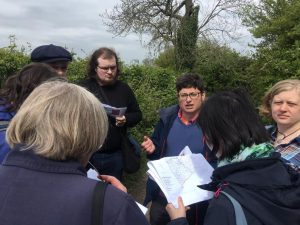
2017-12-04, by Judith Jesch
Lunchtime Lecture Preview: Assembling Vikings: Thinking through Things in the East Midlands
By John Baker
A feature of the Viking diaspora was the establishment of Thing sites, places of regular popular gatherings, where disputes were settled and justice was done. The Old Norse word thing (usually written þing) meant ‘assembly’, and some Thing sites are famous as places of government—Thingvellir, location of the Icelandic Althing, Tinganes, historically the seat of Faroese government, and Tynwald, traditional parliament of the Isle of Man (pictured right, photo by Cassidy Croci).
Place-names, coupled with field-work, has revealed many more such sites across the regions settled by Scandinavian people during the Viking Age, including examples in the East Midlands, such as Thynghowe in Sherwood Forest, Nottinghamshire, which is an Old Norse compound þing-haugr ‘assembly mound’.
However, this tradition of public assembly was shared by the Anglo-Saxons. Among the range of vocabulary they used to describe these places of governance was Old English þing, the direct cognate of the Old Norse word, but other elements, such as mæðel ‘speech, assembly’ and (ge)mōt ‘meeting’ are more distinctively Old English. Anglo-Saxon sources give us a reasonable idea of the development of public assembly in England. By combining an analysis of place-names with careful field-work and archaeological assessment, we are able to identify these important sites and learn more about their function in the landscape and their role within local society.
To find out more about thing sites attend Dr John Baker’s lecture Assembling Vikings: Thinking through things in the East Midlands on 6 December 2017, 1:30-2:30pm at Lakeside Arts Centre room A30.
No comments yet, fill out a comment to be the first


Leave a Reply